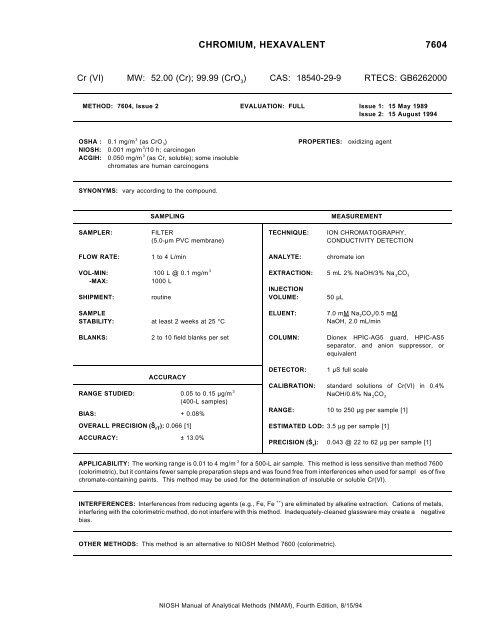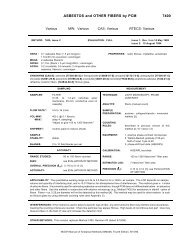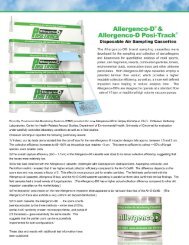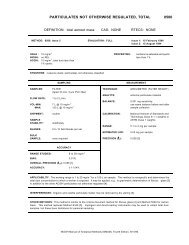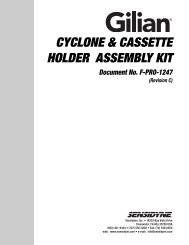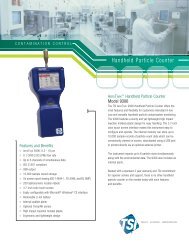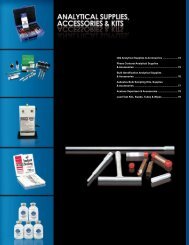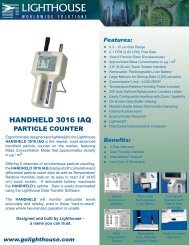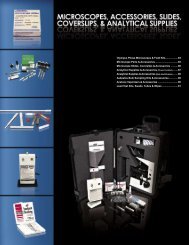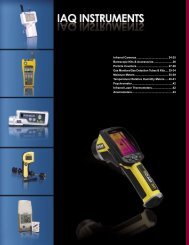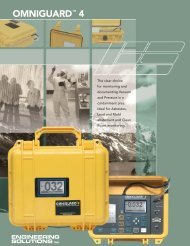CHROMIUM, HEXAVALENT 7604
CHROMIUM, HEXAVALENT 7604
CHROMIUM, HEXAVALENT 7604
You also want an ePaper? Increase the reach of your titles
YUMPU automatically turns print PDFs into web optimized ePapers that Google loves.
<strong>CHROMIUM</strong>, <strong>HEXAVALENT</strong>: METHOD <strong>7604</strong>, Issue 2, dated 15 August 1994 - Page 2 of 3REAGENTS:1. Sodium carbonate, anhydrous.2. Sodium hydroxide, reagent grade.3. Extraction solution, 2% NaOH/3% Na 2 CO 3 .Dissolve 20 g NaOH and 30 g Na 2 CO 3 indeionized water to make 1 L of solution.4. Eluent, 7.0 m M Na 2 CO 3 -0.5 mM NaOH.Dissolve 2.97 g Na 2 CO 3 in 4 L deionizedwater. Add 20 mL of 0.1 M NaOH (8g/L).5. Suppressor regenerant, 0.025 N H 2 SO 4 .Dilute 2.8 mL of conc. H 2 SO 4 in deionizedwater to 4 L.6. Cr(VI) standard, 1000 µg/mL.7. Calibration stock solution, 100 µg/mL. Dilute1000 µg/mL Cr(VI) standard 1:100 withdistilled or deionized water.8. Nitrogen, purified.9. Water, distilled or deionized.* See SPECIAL PRECAUTIONS.EQUIPMENT:1. Sampler: polyvinyl chloride (PVC) filter,5.0-µm pore size, 37-mm diameter (FWSB[MSA] or VM-1 [Gelman], or equivalent) withbackup pad in polystyrene cassette filterholder.NOTE: Some PVC filters promote reductionof Cr(VI). Check each lot of filters forrecovery of Cr(VI) standard.2. Personal sampling pump, 1 to 4 L/min, withflexible connecting tubing.3. Ion chromatograph, with conductivity detector,columns, suppressor (p. <strong>7604</strong>-1).4. Vials, scintillation 20-mL glass, PTFE-linedscrew cap.5. Forceps, plastic.6. Syringe, 10-mL, with in-line membrane filter0.45-µm pore size.7. Beakers, borosilicate, 50-mL.8. Watchglasses.9. Volumetric, flasks, 25-, 100-, and 1000-mL.10. Hotplate, 120 to 400 °C.11. Micropipette, 20-µL, and other sizes.12. Centrifuge tubes, 40-mL, graduated, withplastic, screw caps.SAMPLING:SPECIAL PRECAUTIONS: Insoluble chromatesare suspected human carcinogens [2]. All samplepreparation should be performed in a hood.1. Calibrate each personal sampling pumpwith a representative sampler in line.2. Sample at an accurately known flow rate in the range 1 to 4 L/min for a sample size of 100 to1000 L. Do not exceed 2 mg of particulate loading on the filter.3. Remove the filter from the cassette within 1 hour of completion of sampling, and place it in avial to be shipped to the laboratory. Handle the filters only with forceps. Discard the backuppad.SAMPLE PREPARATION:4. Place the filter face down in a 50-mL beaker, and add 5.0 mL extraction solution. Start reagentblanks at this point.NOTE 1: If significant amounts of Cr(III) are expected to be present, degas the extractionsolution by bubbling a slow stream of nitrogen through it for 5 min before proceedingand purge the headspace above the solution with nitrogen during this step.NOTE 2: If only soluble chromates are of interest use distilled water in place of extractionsolution.5. Cover the beaker with a watchglass and place on a hotplate preheated to 135 °C. Heat thesamples for 45 min with occasional swirling.NOTE 1: Do not allow the solution to boil or evaporate to dryness. Hexavalent chromium maybe lost by reaction with the PVC filter, as indicated by a brown coloring in the filter.NOTE 2: Longer heating times, up to 90 min. may be necessary for some samples (e.g., paintspray [1]).6. Cool the solution and transfer it quantitatively with distilled water rinses to a graduatedNIOSH Manual of Analytical Methods (NMAM), Fourth Edition, 8/15/94
<strong>CHROMIUM</strong>, <strong>HEXAVALENT</strong>: METHOD <strong>7604</strong>, Issue 2, dated 15 August 1994 - Page 3 of 3centrifuge tube. Adjust the final volume to 25 mL with distilled water.CALIBRATION AND QUALITY CONTROL:7. Calibrate daily with at least six working standards over the range of 0 to 250 µg Cr (VI) persample.a. Pipet 0 to 2.5 mL calibration stock solution into each of a series of 25-mL volumetric flasks.Add 5 mL extraction solution to each flask and dilute to the mark with deionized water.b. Analyze the working standards (steps 8 through 10).c. Prepare a calibration graph [peak height vs. µg Cr(VI) per sample].MEASUREMENT:8. Set ion chromatograph according to manufacturer's recommendations and to conditions on page<strong>7604</strong>-1. Set regenerant flow to 3 mL/min.9. Inject 50 µL sample aliquot manually or with autosampler.NOTE: All samples and standards must be filtered before injection to avoid plugging columnsand lines.10. Measure peak height. (Retention time for Cr(VI) peak is approximately 12 min under theseconditions.)CALCULATIONS:11. From the calibration graph, determine the mass of Cr(VI) in each sample, W (µg), and in theaverage blank, B (µg).12. Calculate the concentration, C (mg/m 3 ), of Cr(VI) in the air volume sampled, V (L):EVALUATION OF METHOD:This method was evaluated with three sets of 16 filter samples which were collected from achromate-containing paint aerosol [2]. The average amount of Cr(VI) on the filter ranged from 24 to 62micrograms. Half of the samples were analyzed by this method while the other half were analyzed byMethod 7300 (ICP). The results were not significantly different at the 95% confidence level. Toexamine sample stability, selected members of a fourth set of filters were analyzed and the remainderwere stored for two weeks under cover in a constant temperature and constant humidity environment.Comparison of the results of analysis before and after storage indicated that the amount of Cr(VI) didnot change during this period.REFERENCES:[1] Molina, D. and M. T. Abell. An Ion Chromatographic Method for Insoluble Chromium in PaintAerosol. Am. Ind. Hyg. Assoc. J. 48:830-835 (1987).[2] NIOSH Testimony on the OSHA Proposal Rules on Air Contaminants, Docket #H-020,August 1, 1988.METHOD REVISED BY:Martin T. Abell, NIOSH/DPSE.NIOSH Manual of Analytical Methods (NMAM), Fourth Edition, 8/15/94


